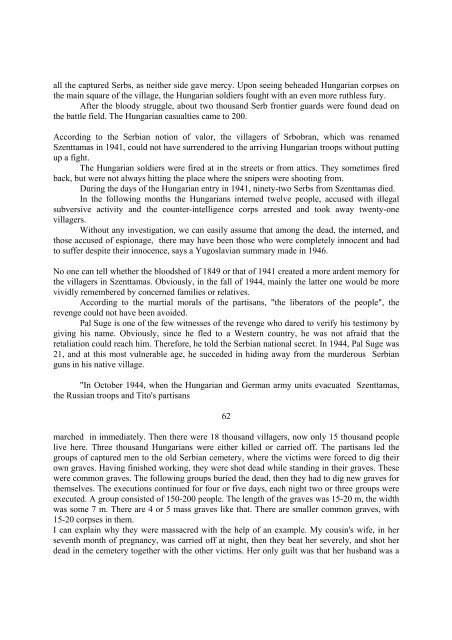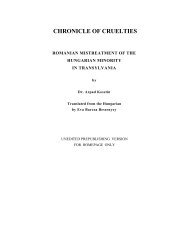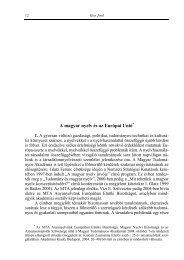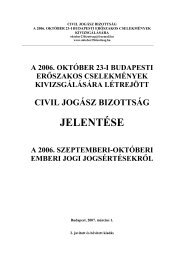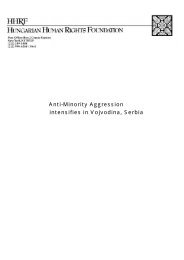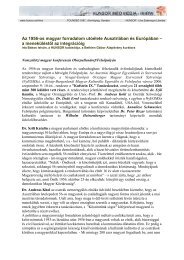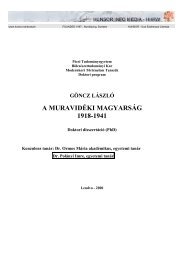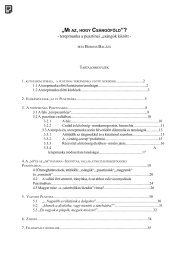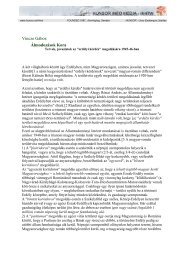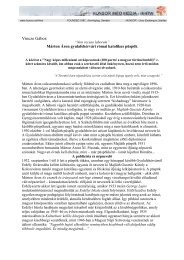all the captured Serbs, as neither side gave mercy. Upon seeing beheaded Hungarian corpses onthe main square of the village, the Hungarian soldiers fought with an even more ruthless fury.After the bloody struggle, about two thousand Serb frontier guards were found dead onthe battle field. The Hungarian casualties came to 200.According to the Serbian notion of valor, the villagers of Srbobran, which was renamedSzenttamas in 1941, could not have surrendered to the arriving Hungarian troops without puttingup a fight.The Hungarian soldiers were fired at in the streets or from attics. They sometimes firedback, but were not always hitting the place where the snipers were shooting from.During the days of the Hungarian entry in 1941, ninety-two Serbs from Szenttamas died.In the following months the Hungarians interned twelve people, accused with illegalsubversive activity and the counter-intelligence corps arrested and took away twenty-onevillagers.Without any investigation, we can easily assume that among the dead, the interned, andthose accused of espionage, there may have been those who were completely innocent and hadto suffer despite their innocence, says a Yugoslavian summary made in 1946.No one can tell whether the bloodshed of 1849 or that of 1941 created a more ardent memory forthe villagers in Szenttamas. Obviously, in the fall of 1944, mainly the latter one would be morevividly remembered by concerned families or relatives.According to the martial morals of the partisans, "the liberators of the people", therevenge could not have been avoided.Pal Suge is one of the few witnesses of the revenge who dared to verify his testimony bygiving his name. Obviously, since he fled to a Western country, he was not afraid that theretaliation could reach him. Therefore, he told the Serbian national secret. In 1944, Pal Suge was21, and at this most vulnerable age, he succeded in hiding away from the murderous Serbianguns in his native village."In October 1944, when the Hungarian and German army units evacuated Szenttamas,the Russian troops and Tito's partisans62marched in immediately. Then there were 18 thousand villagers, now only 15 thousand peoplelive here. Three thousand Hungarians were either killed or carried off. The partisans led thegroups of captured men to the old Serbian cemetery, where the victims were forced to dig theirown graves. Having finished working, they were shot dead while standing in their graves. Thesewere common graves. The following groups buried the dead, then they had to dig new graves forthemselves. The executions continued for four or five days, each night two or three groups wereexecuted. A group consisted of 150-200 people. The length of the graves was 15-20 m, the widthwas some 7 m. There are 4 or 5 mass graves like that. There are smaller common graves, with15-20 corpses in them.I can explain why they were massacred with the help of an example. My cousin's wife, in herseventh month of pregnancy, was carried off at night, then they beat her severely, and shot herdead in the cemetery together with the other victims. Her only guilt was that her husband was a
Hungarian soldier and an arrow-cross man (i.e. member of the Hungarian Nazi party), though hedid not hold any office. A woman, between 40-45 years old, crawled out of the common grave,but she bled to death about 100 metres from there. By the next day, hungry stray dogs had tornher body to pieces. Those who had Serbian enemies were all slaughtered, including theirfamilies. All those whose Chetnik sons had been convicted by the Hungarian authorities hadtheir revenge."Though all Hungarian villagers in Szenttamas suffered a great deal during the reign ofterror, all of them cannot be included among the victims, as some emigrated from there, or diednatural deaths. So our sad summary does not have an exact final result.According to even a conservative estimate, the number of the executed is above onethousand. The greatest possible number is around two thousand. The unrestrained killing andmost of the executions lasted four days. Thereafter, Hungarians were murdered in Szenttamasonly occasionally.Three common graves were in the cemetery, but there were other graves at the lumbermill, and at the cloister.An eight-year-old girl had accidentally witnessed the slaughter unobserved, and told herparents what she had seen. The neighbors heard the child's report, too. Rumor had it that theinnocent little girl had "harmful" news. The next day the partisans took away the little witnessand executed her.In 1941, seven Serb men died by rifle fire in Bacsfoldvar, and63another seven were arrested by the counter-intelligence in the following years.In 1944, in the same village seventy innocent Hungarian men were led to the bank of theTisza and shot, so that their bodies fell into the river near Gyongy Island.None of the remaining Hungarians in Foldvar remember the 1848 beheading ofHungarian children by the rebel Serbian Frontierguards....SZIVACAt the beginning of the 1940s, seven Serbian men from Szivac were imprisoned andinvestigated by the Hungarian counter-intelligence. Szivac was inhabited by three nationalities,who had lived together in peace for centuries."...I am determined to send you a roll including the names of those who were executed(annihilated) in the morning, on November 1, 1944, because I have been a victim of atrocitiesmyself. It is true that because of the repeated threats all this has been taboo for me, and I did notdare to tell anyone but my family. Honestly, the fear is still alive in me. It is true that newspapersare beginning to publish data concerning these events gradually, but the survivors still do notdare to speak, give their names, or make exact data known, because there is no "democracy", nohuman right to freedom. Only the name has changed, the power has remained the same.I was born in February 1923, in O-Szivac (now Sivac). Then the village was part ofZombor, now it is attached to Kula.
- Page 3 and 4: Library of Congress Catalogue Card
- Page 5 and 6: Mutilation of the hands or feet wit
- Page 7 and 8: they wanted to belong. On the annex
- Page 9 and 10: individuals, then shooting them by
- Page 11 and 12: the Russians and under their protec
- Page 13 and 14: 22PEOPLE OF BEZDAN1.On a May aftern
- Page 16 and 17: 26that those people all fell victim
- Page 18 and 19: ack a 13 year-old boy to the soccer
- Page 20 and 21: Russian officers cursed and told th
- Page 22 and 23: Jani was set free for he had been a
- Page 24 and 25: There were some people who, in spit
- Page 26 and 27: March 12, 1945. The relatives of th
- Page 28 and 29: Ferenc Csapo, 33 Mihaly Miovacs, 18
- Page 30 and 31: Having heard about the advance of t
- Page 32 and 33: "On November 3, I got up at five in
- Page 34 and 35: The vicar would come every night. H
- Page 36 and 37: hand. Raising it to his mouth, he d
- Page 38 and 39: "24th October, 1944. Yesterday was
- Page 40 and 41: "I have only one chance to be sacri
- Page 42 and 43: The data, which shows that on the s
- Page 46 and 47: Before and during World War II, the
- Page 48 and 49: would order fire in an instant. Wit
- Page 50 and 51: Our house looked out over the main
- Page 52 and 53: He had just arrived home after thre
- Page 54 and 55: 28. Jozsef Pasztor, 34 56. Albert G
- Page 56 and 57: The OZNA officer, who exhumed a mas
- Page 58 and 59: 7917 year old Karoly and 8 year old
- Page 60 and 61: 82FROM SZENTFULOP TO THE GAKOVA CAM
- Page 62 and 63: My mother died on January 4, 1946.
- Page 64 and 65: Jozsi, the leader of our committee
- Page 66 and 67: his own grave, then machine gunned
- Page 68 and 69: driving a wheelbarrow on the sidewa
- Page 70 and 71: "Now that's exactly what we needed
- Page 72 and 73: 15 Istvan Polyakovics, Zenta, 18861
- Page 74 and 75: idge was built (from several rows o
- Page 76 and 77: There is a common opinion among the
- Page 78 and 79: The Catholics of the village were o
- Page 80 and 81: and their supporters. On one occasi
- Page 82 and 83: "My younger brother, Bandi, was tak
- Page 84 and 85: two young instructors staying in he
- Page 86 and 87: In Tunderes (Vilova) there was no o
- Page 88 and 89: weeks spent starving, laying on str
- Page 90 and 91: 121PACSERAt Pacser sixteen Serbians
- Page 92 and 93: piece of land, there are three rows
- Page 94 and 95:
"I understood that through the OZNA
- Page 96 and 97:
took the priest under their protect
- Page 98 and 99:
"We set off from Hadikliget on Octo
- Page 100 and 101:
everyone to the front! The Party us
- Page 102 and 103:
137REPORT OF LOSSESIn addition to o
- Page 104 and 105:
141Source: Zlocini okupatora u Vojv
- Page 106 and 107:
well as in words, that there had be
- Page 108 and 109:
The American military forces delive
- Page 110 and 111:
culpability or participation are th
- Page 112 and 113:
The accused did not make use of his
- Page 114 and 115:
the spirit of revenge among the Hun
- Page 116 and 117:
considered all the claims of Hungar
- Page 118 and 119:
The People's Court of Budapest just
- Page 120 and 121:
From then on all hell breaks loose.
- Page 122 and 123:
Recommended readingeRudolf Kiszlion


